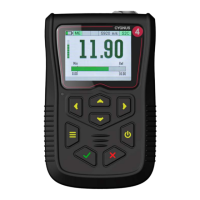14
Measurement Modes Explained and Compared
Multiple Echo Mode (Mode 3)
Multiple Echo measurement mode is by far the most reliable and
easy method for thickness measurements, because it works by
looking for three matched echoes it can verify the thickness
measurement is valid. This method has been used in all Cygnus
gauges since the late 1970s.
Multiple echo mode will ignore surface coatings, there is no need
to remove the paint to take a measurement.
Also because it uses a single element (or single crystal) probe
there are no errors due to the V-path of the ultrasound beam
found in all twin element probes. This makes it simple to calibrate
– two point calibrations are not required.
However because it requires three echoes to take a measurement,
in heavily corroded steels there is often an insufficient number of
echoes so no measurement is possible.
Measuring Non-Steels
The gauge will measure the following non-steels;
• Aluminium alloys
• Copper and Brass alloys
• Titanium
Use the same rules as steels when selecting a suitable probe. The
gauge will ideally be re-calibrated to suit the metal being
measured, or the standard velocity of sound for that material
would be entered into the gauge.
Measuring Non-Metals
The gauge is not suitable for measuring non-metals. Typically
these materials cannot be measured with this gauge model;
• Plastics
• Concrete

